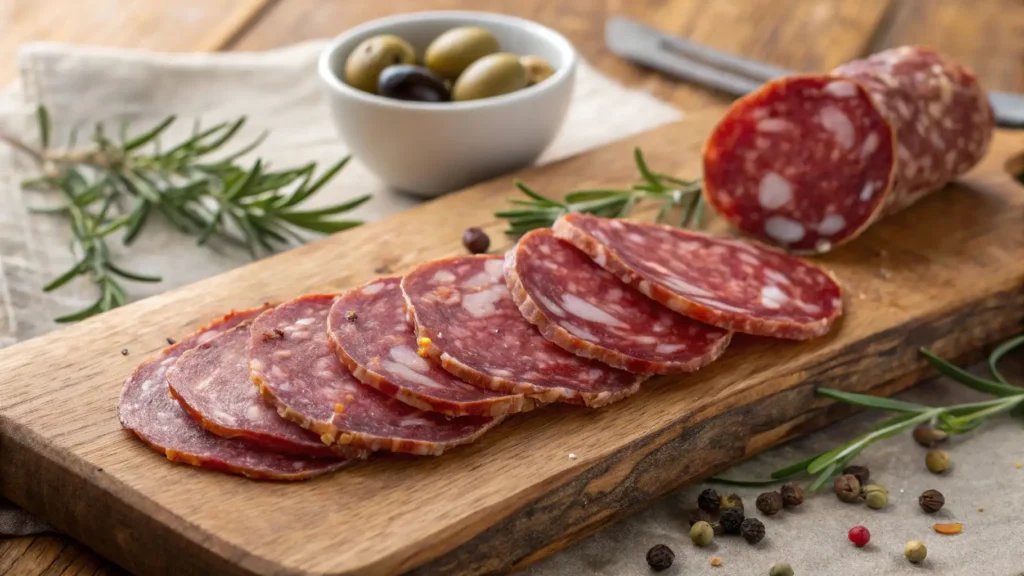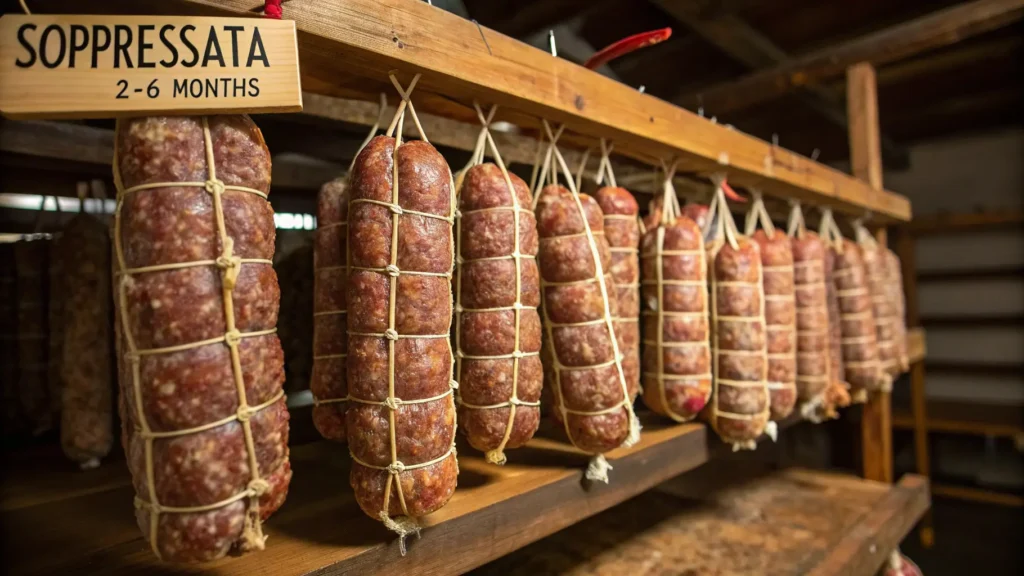Soppressata, a staple in Italian cuisine, is a cured meat that boasts bold flavors and a rustic texture. Recognized for its versatility, it can be enjoyed on its own, added to recipes, or showcased on charcuterie boards. With regional variations and rich culinary traditions, soppressata holds a special place in Italy’s gastronomic heritage.

This guide dives into what sets soppressata apart, the types you can find, the process behind making it, and the best ways to incorporate it into your meals. Whether you’re an experienced foodie or just starting to explore Italian cuisine, it brings bold flavors and endless possibilities to your table.
What Is Soppressata?
Overview
Soppressata, a type of Italian cured salami, delivers robust flavor and a coarse texture. Unlike finely ground salami, producers hand-cut or roughly grind the meat to create its rustic and hearty character. They typically season it with spices such as black pepper, fennel seeds, or chili flakes before curing it to enhance its distinct flavor.
Traditionally crafted with pork, regional variations sometimes include beef or a mix of meats, reflecting local preferences. People across Italy enjoy soppressata, and its authentic taste and versatility have helped it gain worldwide popularity.
Origins of Soppressata in Italy
The origins of soppressata trace back to Southern Italy, particularly regions like Calabria, Basilicata, and Puglia. Each area has its own take on the salami, influenced by local ingredients and culinary traditions.
In Calabria, it’s often spicy, reflecting the region’s love for chili peppers, while in Tuscany and Puglia, milder versions with aromatic herbs are more common. Historically, it was a way for families to preserve meat during the winter months, ensuring they had flavorful, protein-rich food year-round.
Types
Soppressata di Calabria DOP
It’s one of the most famous varieties, recognized for its high quality and adherence to traditional methods. This version uses specific cuts of pork, such as shoulder and ham, and is seasoned with Calabrian chili peppers, black pepper, and salt. Its unique flavor profile and authenticity make it a standout choice for cured meat enthusiasts.
Sweet vs. Spicy Soppressata
It comes in two distinct varieties, each offering a unique flavor profile that enhances different culinary experiences:

✅ Sweet Soppressata (Dolce) – This milder version features subtle seasonings like fennel seeds, black pepper, and garlic. Its smooth, slightly savory taste makes it a versatile ingredient, ideal for charcuterie boards, sandwiches, and pasta dishes.
✅ Spicy Soppressata (Piccante) – Infused with chili flakes, hot paprika, or cayenne pepper, this variety delivers a bold, fiery kick. It pairs exceptionally well with aged cheeses, crusty bread, and robust red wines, making it a favorite for those who enjoy heat.
How Soppressata Is Made
The traditional preparation follows time-honored techniques, using simple yet essential ingredients that contribute to its rich flavor and firm texture.
✅ Pork or Other Meats – Traditionally crafted from high-quality cuts like pork shoulder and ham, though some varieties may include beef or a combination of meats for a unique twist.
✅ Fat Content – Pork belly or back fat is carefully incorporated to ensure richness, moisture, and depth of flavor.
✅ Spices & Seasonings – Depending on regional preferences, soppressata is flavored with ingredients like:
• Black Pepper & Fennel Seeds (for a mild, aromatic profile)
• Chili Flakes & Paprika (for a spicy, smoky heat)
• Garlic & Red Wine (for added depth and complexity)
✅ Salt & Curing Process – Salt is crucial for preservation, helping to cure and enhance the flavor over time.
✅ Casing & Aging – The seasoned meat mixture is encased in natural or synthetic casings, then hung to dry and cure for several weeks to develop its signature taste and texture.
Whether you prefer sweet or spicy soppressata, its rich, bold flavors make it a standout ingredient in both traditional and modern dishes!
Curing and Aging Process
The process of making involves several traditional steps, each contributing to its unique flavor and texture:

- Meat Preparation: Begin by coarsely grinding or hand-cutting the meat, then mix it thoroughly with seasonings and fat to ensure an even distribution of flavors.
- Stuffing: Next, pack the mixture into casings, tie them securely, and shape them into their signature flattened form for easy handling.
- Pressing: Lightly press the sausages to achieve their distinct shape. This step, inspired by the Italian word soppressare (meaning “to press”), is crucial for the final appearance.
- Curing: Finally, hang the it in a controlled environment to dry and cure for 2–6 months. As the curing progresses, the flavors deepen, and the texture becomes firmer, delivering the robust taste and satisfying bite soppressata is known for.
By following these steps with care, artisans create the bold, authentic soppressata enjoyed worldwide.Artisan producers often follow centuries-old methods, ensuring it retains its traditional character.
How to Use Soppressata
Soppressata is a flavorful, versatile cured meat that can enhance a variety of dishes. Whether enjoyed on its own or incorporated into recipes, its bold, rich taste makes it a favorite among food lovers.
In Charcuterie Boards
Soppressata is a standout addition to any charcuterie board, offering a rustic, savory element that pairs beautifully with an array of complementary flavors. To create the perfect balance, pair it with:
✅ Cheeses – Aged cheeses like Parmesan, Pecorino Romano, or Manchego add a sharp contrast, while soft cheeses like goat cheese or Brie bring a creamy, mild touch.
✅ Fruits – Fresh figs, grapes, and dried apricots provide a natural sweetness that balances soppressata’s salty and spicy notes. You can also try honey or fruit preserves for an extra layer of contrast.
✅ Crackers or Bread – Serve soppressata with rustic baguettes, crisp crackers, or grissini breadsticks for the perfect crunch. A drizzle of olive oil or balsamic glaze can elevate the experience even further.
For a more dynamic charcuterie spread, consider adding olives, roasted nuts, pickled vegetables, or whole grain mustard to complement the flavors of the soppressata. Whether sweet or spicy, this cured delicacy brings depth and character to any appetizer platter!
Culinary Applications in Recipes
Soppressata’s versatility seamlessly extends to a wide range of recipes, making it a favorite ingredient in various dishes:

- Pizzas: For a smoky, spicy kick, add thin slices to homemade pizzas. The rich flavors of soppressata enhance the overall taste and pair well with melted cheese and fresh toppings.
- Pasta Dishes: To create a flavorful twist, toss diced pieces into pasta along with olive oil, garlic, and fresh herbs. This simple addition instantly elevates the dish’s complexity and aroma.
- Sandwiches: When preparing paninis or deli-style sandwiches, layer slices of soppressata for added depth and a satisfying savory touch. Its bold flavor complements cheeses and spreads effortlessly.
- Omelets: For a hearty breakfast, incorporate chopped pieces into your omelet. The savory salami adds richness and texture, turning a simple egg dish into a more robust meal.
These uses showcase the ingredient’s ability to elevate both simple and sophisticated dishes.
Frequently Asked Questions (FAQs)
Is Soppressata Different from Regular Salami?
Is It Different from Regular Salami?
Yes, this Italian cured meat stands apart from regular salami in texture and flavor. Producers use coarsely ground or hand-cut meat, giving it a rustic and hearty character. Its seasoning is often bolder, with chili flakes or fennel seeds frequently added, depending on the regional variety. These unique touches create its distinctive and robust taste.
Can You Eat It Raw?
Although it may look raw, this salami is cured, meaning it undergoes a drying and aging process that preserves it and develops its flavor.
It is completely safe to eat straight from the package, making it a convenient choice for snacks, charcuterie boards, or various recipes.
How Should Soppressata Be Stored?
Proper storage is essential to preserve the flavor and quality. For unopened soppressata, follow the packaging instructions carefully. Typically, you can store it in a cool, dry place, such as a pantry, or in the refrigerator to maintain its freshness.
Once opened, take extra steps to ensure it stays flavorful. Wrap the salami tightly in plastic wrap, parchment paper, or even aluminum foil to prevent air exposure, which can dry it out or lead to spoilage. Always refrigerate opened it and aim to consume it within a few weeks for the best taste and texture. If you want to extend its shelf life further, consider slicing and freezing portions, but remember that freezing may slightly alter its texture.
Is Soppressata Spicy?
The level of spiciness depends entirely on the variety. Spicy versions use seasonings like chili flakes or hot peppers, delivering a bold and fiery kick that appeals to those who enjoy heat in their cured meats.
On the other hand, sweet versions have a much milder flavor profile, emphasizing the natural richness of the pork and the subtle aromas of spices such as fennel seeds or black pepper. Both options offer unique and delicious flavor experiences, catering to different taste preferences.
What Wines Pair Well with Soppressata?
Soppressata pairs beautifully with bold red wines that enhance its robust and savory flavor. Here are some excellent wine options:
- Chianti: This classic Italian red complements the rich, meaty flavors of soppressata with its earthy and slightly tangy profile.
- Barbera: A lighter red wine with bright acidity, Barbera cuts through the fat, balancing the richness of the cured meat.
- Zinfandel: Known for its fruity and spicy notes, Zinfandel enhances the bold seasoning in soppressata, especially in spicy varieties.
For those enjoying spicy soppressata, wines with a touch of sweetness, such as Lambrusco or Riesling, provide a pleasing contrast to the heat while highlighting the salami’s complex flavors. Pairing the right wine elevates the experience, making it perfect for charcuterie boards or sophisticated meals.a touch of sweetness, like Lambrusco or Riesling, to balance the heat.
Conclusion
Soppressata is much more than a cured salami—it’s a testament to Italy’s rich culinary heritage. With its bold flavors, rustic texture, and regional variations, soppressata has earned a special place in kitchens and charcuterie boards worldwide.
Whether you enjoy it on its own, pair it with cheese and wine, or incorporate it into recipes, soppressata brings a depth of flavor that elevates any dish. Exploring its history, types, and uses allows you to fully appreciate this iconic Italian delicacy.
For more culinary inspiration, check out Delicious Baked Ziti Recipe (No Meat) or explore pairing ideas with What SauceGoes on Salmon?.
